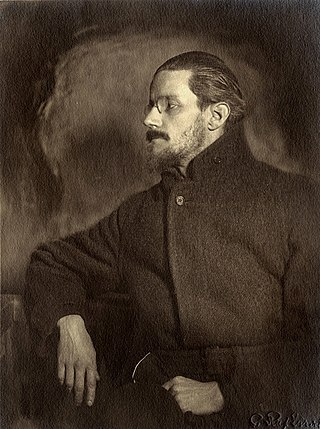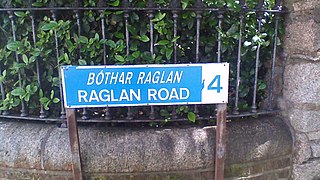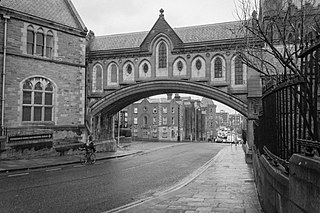
James Augustine Aloysius Joyce was an Irish novelist, poet and literary critic. He contributed to the modernist avant-garde movement and is regarded as one of the most influential and important writers of the 20th century. Joyce's novel Ulysses (1922) is a landmark in which the episodes of Homer's Odyssey are paralleled in a variety of literary styles, particularly stream of consciousness. Other well-known works are the short-story collection Dubliners (1914), and the novels A Portrait of the Artist as a Young Man (1916) and Finnegans Wake (1939). His other writings include three books of poetry, a play, letters, and occasional journalism.

Ulysses is a modernist novel by the Irish writer James Joyce. Parts of it were first serialized in the American journal The Little Review from March 1918 to December 1920, and the entire work was published in Paris by Sylvia Beach on 2 February 1922, Joyce's fortieth birthday. It is considered one of the most important works of modernist literature and has been called "a demonstration and summation of the entire movement". According to the writer Declan Kiberd, "before Joyce, no writer of fiction had so foregrounded the process of thinking".

A Portrait of the Artist as a Young Man is the first novel of Irish writer James Joyce, published in 1916. A Künstlerroman written in a modernist style, it traces the religious and intellectual awakening of young Stephen Dedalus, Joyce's fictional alter ego, whose surname alludes to Daedalus, Greek mythology's consummate craftsman. Stephen questions and rebels against the Catholic and Irish conventions under which he has grown, culminating in his self-exile from Ireland to Europe. The work uses techniques that Joyce developed more fully in Ulysses (1922) and Finnegans Wake (1939).

Dubliners is a collection of fifteen short stories by James Joyce, first published in 1914. It presents a naturalistic depiction of Irish middle class life in and around Dublin in the early years of the 20th century.
"The Dead" is the final short story in the 1914 collection Dubliners by James Joyce. It is by far the longest story in the collection and, at 15,952 words, is almost long enough to be described as a novella. The story deals with themes of love and loss, as well as raising questions about the nature of the Irish identity.
"Rocky Road to Dublin" is a 19th-century Irish song written by Irish poet D. K. Gavan about a man's experiences as he travels to Liverpool, England from his home in Tuam, Ireland. Originally popularized by Harry Clifton, it has since been performed extensively and become a standard of Irish folk music. The song is also often performed instrumentally.
"Eveline" is a short story by the Irish writer James Joyce. It was first published in 1904 by the journal Irish Homestead and later featured in his 1914 collection of short stories Dubliners. It tells the story of Eveline, a teenager who plans to leave Dublin for Argentina with her "lover".
"Araby" is a short story by James Joyce published in his 1914 collection Dubliners. The story traces a young boy's infatuation with his friend's sister.
"A Little Cloud" is a short story by James Joyce, first published in his 1914 collection Dubliners. It contrasts the life of the protagonist, Little Chandler, a Dubliner who remained in the city and married, with the life of his old friend Ignatius Gallaher, who had left Ireland to find success and excitement as a journalist and bachelor in London.
"A Painful Case" is a short story by Irish author James Joyce published in his 1914 collection Dubliners. The story details a platonic affair between an isolated man and a married woman, the breaking off of the affair, and its aftermath.
"Ivy Day in the Committee Room" is a short story by James Joyce published in his 1914 collection Dubliners. Taking place in a political party office after a day of canvassing, the story depicts various campaigners discussing the political candidates and issues of Irish nationalism and Home Rule. "Ivy Day" refers to an Irish holiday that commemorated Charles Stewart Parnell, an important Irish nationalist figure.

The Bohemian Girl is an Irish Romantic opera composed by Michael William Balfe with a libretto by Alfred Bunn. The plot is loosely based on a Miguel de Cervantes' tale, La gitanilla.

"On Raglan Road" is a well-known Irish song from a poem written by Irish poet Patrick Kavanagh named after Raglan Road in Ballsbridge, Dublin. In the poem, the speaker recalls, while walking on a "quiet street," a love affair that he had with a much younger woman. Although he knew he would risk being hurt if he initiated a relationship, he did so anyway, and ultimately faced heartache after the relationship ended.
"The Waxies' Dargle" is a traditional Irish folk song about two Dublin "aul' wan" discussing how to find money to go on an excursion. It is named after an annual outing to Ringsend, near Dublin city, by Dublin cobblers (waxies). It originated as a 19th-century children's song and is now a popular pub song in Ireland.
"I Dreamt I Dwelt in Marble Halls", or "The Gipsy Girl's Dream", is a popular aria from The Bohemian Girl, an 1843 opera by Michael William Balfe, with lyrics by Alfred Bunn. It is sung in the opera by the character Arline, who is in love with Thaddeus, a Polish nobleman and political exile.
"Two Gallants" is a short story by James Joyce published in his 1914 collection Dubliners. It tells the story of two Irishmen who are frustrated with their lack of achievement in life and rely on the exploitation of others to live. Joyce considered the story to be one of the most important in Dubliners.
Epiphany in literature refers generally to a visionary moment when a character has a sudden insight or realization that changes their understanding of themselves or their comprehension of the world. The term has a more specialized sense as a literary device distinct to modernist fiction. Author James Joyce first borrowed the religious term "Epiphany" and adopted it into a profane literary context in Stephen Hero (1904–1906), an early version of A Portrait of the Artist as a Young Man. In that manuscript, Stephen Daedalus defines epiphany as "a sudden spiritual manifestation, whether in the vulgarity of speech or of gesture or in a memorable phase of the mind itself." Stephen's epiphanies are moments of heightened poetic perception in the trivial aspects of everyday Dublin life, non-religious and non-mystical in nature. They become the basis of Stephen's theory of aesthetic perception as well as his writing. In similar terms, Joyce experimented with epiphany throughout his career, from the short stories he wrote between 1898 and 1904 which were central to his early work, to his late novel Finnegans Wake (1939). Scholars used Joyce's term to describe a common feature of the modernist novel, with authors as varied as Virginia Woolf, Marcel Proust, Ezra Pound, and Katherine Mansfield all featuring these sudden moments of vision as an aspect of the contemporary mind. Joycean or modernist epiphany has its roots in nineteenth-century lyric poetry, especially the Wordsworthian "spots of time," as well as the sudden spiritual insights that formed the basis of traditional spiritual autobiography. Philosopher Charles Taylor explains the rise of epiphany in modernist art as a reaction against the rise of a “commercial-industrial-capitalist society” during the early twentieth century.

Winetavern Street is a street in the medieval area of Dublin, Ireland.
Dublin by Lamplight or the Lamplight Laundry, at 35 Ballsbridge Terrace, Ballsbridge, Dublin, was a Protestant-run Magdalene Laundry, founded in 1856, that like other such laundries housed so-called "fallen women". It was administered by a committee of Anglican women, a matron, and a chaplain who was a Church of Ireland priest. The motto of the asylum was "That they may recover themselves out of the snares of the devil".







